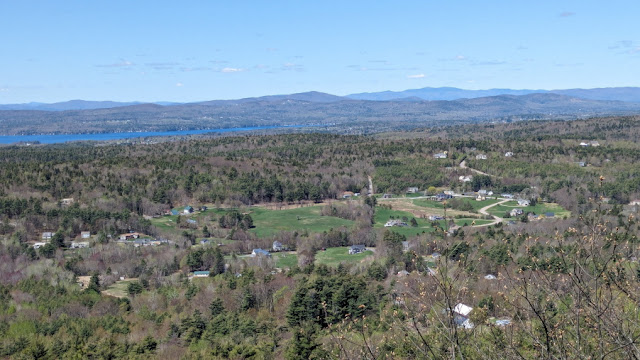There's an old iron mine on the western flank of Gunstock Mountain which I'd never been to, but the Town of Gilford and the Lakes Region Conservation Trust recently improved the trail to the mines so I decided I would check it out. It's a short, half-mile hike up the the site, and along the way there is a very nice viewpoint looking out over Gilford.
 |
| Viewpoint on the Iron Mines Trail |
The mines themselves - there are two sites - are small and not very impressive to look at, but the story is interesting.
 |
| One of two sites where iron ore was mined from the Belknap Mountains |
The mines contained very-high quality iron ore, so high in fact that some was used directly without being smelted. But the deposits were small, and the mine didn't last long. There's a short history posted on the kiosk at the trailhead.
What I find most interesting is that someone discovered the iron deposit in the first place, just two small veins located on a large mountain range. Were there specific topological or geological aspects that attracted their attention? Did the magnetite in the rock make their compass act erratically? Something led them to discover the deposit, and if known, that would be a interesting part of the story.
The Iron Mines Trail connects to the large trail network in the Belknap Range that runs all the way to Mt. Major in Alton. I continued on, completing a loop over Gunstock and Belknap, taking advantage of the nice late-spring day with no bugs and clear sightlines through empty branches.
There is still snow in the White Mountains.
 |
| Snow on Mt. Washington, seen from the summit of Gunstock. |
And on the ski trails.
 |
| Flintlock Trail at Gunstock. This is the trail one can see from Clough Park in Meredith Village |
The waters of Winnipesaukee were shining blue from the ledges on Belknap.
Of course, I had to climb the fire tower.
Back on Lake Wicwas, the wakening forest is entering the mellow-yellow, lemon-lime phase.
 |
| Blue water on Wicwas too. |
Paddling on that blue water this week I had an exciting moment when I came across a single loon that was banded - with a color scheme I'd never seen before!
 |
| Orange with black dot over yellow with black stripe. |
I sent the information off to the Loon Preservation Committee, but they were only able to narrow it down to three loons based just left leg bands. The next day the same loon was here again and I waited patiently hoping to get a right foot wag, but the bird wasn't cooperating. I did get one fuzzy photo of its right leg under water, but that was enough for the LPC biologists to determine its identity: It's a loon that was rescued on January 18th of this year on Paugus Bay in Winnipesaukee. The warm weather this winter had let it stay so long that it had molted its flight feathers and couldn't leave when the bay finally froze over. The team at LPC are thrilled to know their rescue effort was successful. Now we'll watch to see if this loon sticks around at Wicwas, and if so, what kind or turmoil develops during nesting season. You can read the Loon Preservation Committee's report on the rescue here.
While the loons may not have even selected a nesting site yet, the geese have already hatched goslings as seen in this picture from Jim DeMott.
 |
| Six little goslings. Photo by Jim DeMott. |
If all the geese on the lake this year have this many chicks, it's going to be a big year for geese.
Paddling down near the outlet I saw this creature swimming across the lake straight towards a beaver lodge, so I thought is was a beaver - though strange to be out in the middle of the day. But it turned out to be a muskrat.
 |
| A muskrat - note the thin rat-like tail. |
It's always fun to see something different on the lake.
I'll end by noting that the Serviceberry (aka Shadbush) are blooming, and it's about time to look for native cherry trees in bloom. Here's one more picture from my hike in the Belknaps - a pretty Roundleaf Yellow Violet.
 |
| Round-leaved Yellow Violet (Viola rotundifolia) |





Scott….thank you..T
ReplyDeleteThx Scott. So interesting in many respects.
ReplyDeleteThanks for the good read.
ReplyDelete